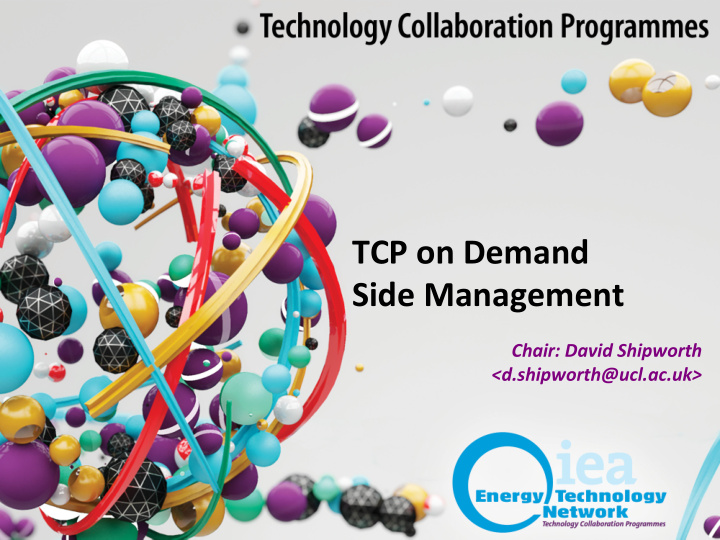



TCP on Demand Side Management Chair: David Shipworth <d.shipworth@ucl.ac.uk>
Where next for the DSM TCP? n The TCP landscape has changed since DSM was created in 1993. There are now TCPs in each major demand sector: 1. Buildings (EBC); Products (4E); Vehicles (HEV); and Industry (IETS). l 4E took on much of DSM’s work (e.g. on product labelling). There is now an increasing role of users in the network. 2. l DER need people to permit, adopt and use them as designers intended. There has been a societal shift towards buying services. 3. n No TCP addresses the role of people in energy technology systems n People use energy through technologies to create social value. l Users have mental models of how to make technologies create value. l Technologies contain their designers’ mental models of users. l Where these don’t match we have problems (e.g. ‘performance gaps’)
Strategy n Why focus on socio-technical issues? l Energy is an intermediary economic good of no intrinsic value (like money). l Consumers engage with energy services & technologies they need/want l Technologies (hardware, software and business models) not adopted or used as intended are energy ineffective and inefficient. l Therefore people (designers, intermediaries and end users) are as integral to delivered energy efficiency as hardware and software.
Strategy n Why focus on socio-technical issues? • Service demand depends how we structure society: Physical Infrastructures: Cycling lanes; heat networks; etc • Temporal structures: Work times; School times; holidays; etc • Social structures: Social norms; cultural expectations; social practices; • Psychological structures: Habits and routines; role modelling; etc • Legal structures: speed limits; property ownership; collab.econ; etc • Economic structures: taxes & charges; subsidies; etc • Knowledge and skills: Information campaigns; skills training; etc •
Current work in the DSM TCP n Restructuring and relaunching in 2020 l Mission: To provide evidence from socio-technical research on energy use to inform policy making for clean energy transitions. l Our Tasks are focused on the needs and roles of users throughout the energy system. Reaching them, understanding their needs, earning their trust, and engaging them by delivering services they find valuable and useable. n Current Task l Energy Service Business Models and Systems n New Tasks n New Task concept notes l Hard to Reach Energy Users l Behavioural Insights Platform l Observatory on P2P & CSC Energy l Best Practices in Energy Trading Efficiency Obligations l Social Licence to Automate l Inclusive algorithms for Energy Optimization
On-going Activities n DSM University l The DSM University (training and capacity building) has continued to host a series of popular webinars, involving thousands of participants from over 120 countries and reaching thousands more through YouTube. w … w DSMU#42: Changing energy behaviour – what works? Karl Purcell, SEAI, Ireland w DSMU#43: Energy Consumption in Europe – why is it increasing and what are the policy implications? Samuel Thomas. Operating Agent DSM TCP, France w DSMU#44: Demand Response in US Markets: Lessons for a low-carbon transformation Mike Hogan, Regulatory Assistance Project, USA (20 December) w DSMU#45: Demand Flexibility as a Resource. Matt Golden, OpenEE, USA (17 October) w DSMU#46: Irish public sector programme. Ryan Alan, Sustainable Energy Authority Ireland (SEAI). w DSMU#47 The IEA Efficient World Scenario (21 March – Today!). w DSMU#48 on EE finance (Joule Assets) on April 18 w DSMU#49 on issues facing ESCOs in different countries (IEA again) on May 23 w …
Recommend
More recommend